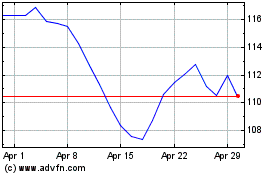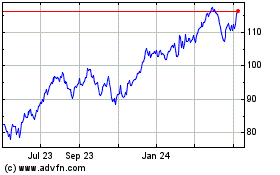Old Long-Term-Care Policies Hurt Prudential Profit
August 01 2018 - 7:34PM
Dow Jones News
By Leslie Scism
Prudential Financial Inc.'s second-quarter net profit tumbled
nearly 60% from the year-earlier period as it bolstered its
reserves for long-term-care insurance policies in a product line it
discontinued in 2012.
In earnings reported Wednesday, both Prudential and longtime
rival MetLife Inc., posted double-digit-percentage gains in their
adjusted operating earnings, which exclude realized capital gains
and losses and other items judged nonrecurring. Operating earnings
are closely watched by analysts and investors as a measure of the
health of continuing operations.
Prudential posted a 40% gain in its operating earnings, and
MetLife reported an 18% increase.
Prudential said its net profit of $197 million included a net
charge of $1.23 billion, or $2.87 a share, in its divested
businesses, primarily driven by the impact of updated actuarial
assumptions. Prudential annually reviews the adequacy of its
assumptions for the profitability of various products in its second
quarter, while MetLife and other insurers update assumptions at
other times. Prudential said the hit was $1.6 billion on a pretax
basis, of which about $1.5 billion was for the long-term-care
policies.
Some Wall Street analysts were anticipating a boost to
Prudential's long-term-care reserves, but Morgan Stanley analysts
said in a note it was "significantly larger than expected."
The Newark, N.J., company is one of many insurers that used to
be big sellers of long-term-care insurance, which helps people pay
for nursing homes, assisted living and home aides. But errors in
pricing the policies have bedeviled many insurers over the past
couple of decades and led many, like Prudential, to quit selling
new policies.
Potentially huge shortfalls in reserves industrywide emerged as
an issue in January, when General Electric Co. disclosed it would
have to set aside $15 billion over seven years to bolster its
long-term-care policyholder reserves. GE was a big reinsurer of
long-term-care for insurers that sold policies to individuals.
MetLife's 18% gain in adjusted earnings came as its net profit
declined 2% to $845 million. MetLife said the decline was largely
tied to divesting its stake in Brighthouse Financial Inc., a
U.S.-focused life-insurance and annuity company it created through
a spinoff a year ago.
MetLife's adjusted earnings jumped to $1.33 billion, or $1.30 a
share, up from $1.12 billion, or $1.04 a share. Analysts surveyed
by Zacks Investment Research were expecting $1.17 a share.
Its year-earlier results were the last quarter to include
results for the retail life-insurance and annuities operations that
are now a part of Brighthouse.
Prudential's operating income rose to $1.3 billion, or $3.01 a
share. Analysts surveyed by Zacks Investment Research expected
$3.08 a share.
MetLife's better-than-expected operating results further
distance it from a rocky stretch as its management dealt with an
embarrassing misstep in its pension-services business. Last fall,
the company disclosed it had failed to pay more than 10,000
retirees whose pension plans it had assumed responsibility for
paying. It acknowledged lackluster efforts to find people in the
past, some of whom were owed money from as far back as the
1990s.
The people with overdue money represent a tiny percentage of the
insurer's overall pension business, but the mistake has had
ramifications. Even as MetLife has worked to get the money into
people's hands, state and federal authorities have been
investigating what went wrong.
Besides its pension business, MetLife's major operations include
an international network of life insurers, one of the nation's
biggest employee-benefits units and a smaller business of selling
home and car insurance in the U.S.
MetLife cited business growth, expense control and lower taxes
in reporting strong results across most of its operating units.
Prudential Chairman and Chief Executive John Strangfeld said the
company had "significantly strengthened the reserves of our
divested businesses, while maintaining a strong capital position."
Its asset-management unit delivered one of the strongest profit
gains across the company.
Prudential said it is "actively pursuing rate increases and
expanding benefit-reduction options" for long-term-care
policyholders. The insurer's long-term-care reserves total $6.6
billion after the reserve boost, it said.
Morgan Stanley analysts said Prudential's large charge to boost
its long-term-care reserves now means the assumptions it is using
are likely "conservative relative to its peers."
Write to Leslie Scism at leslie.scism@wsj.com
(END) Dow Jones Newswires
August 01, 2018 19:19 ET (23:19 GMT)
Copyright (c) 2018 Dow Jones & Company, Inc.
Prudential Financial (NYSE:PRU)
Historical Stock Chart
From Jun 2024 to Jul 2024

Prudential Financial (NYSE:PRU)
Historical Stock Chart
From Jul 2023 to Jul 2024
